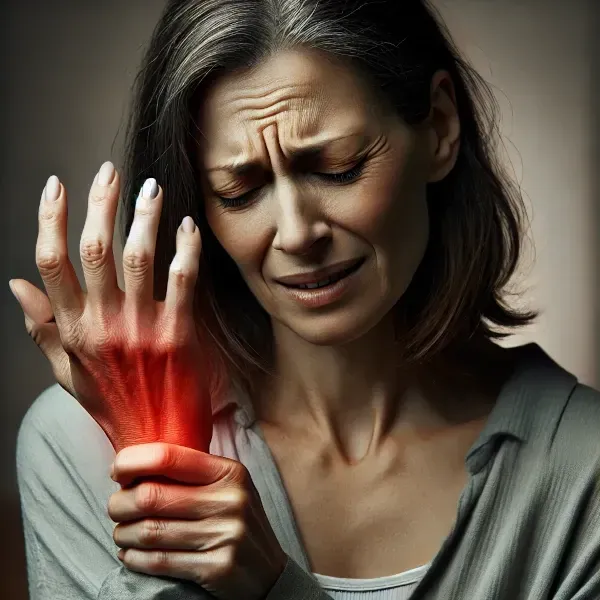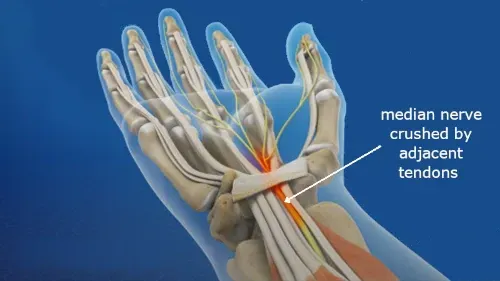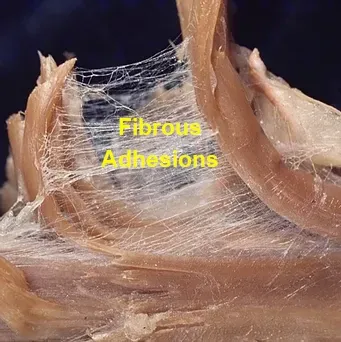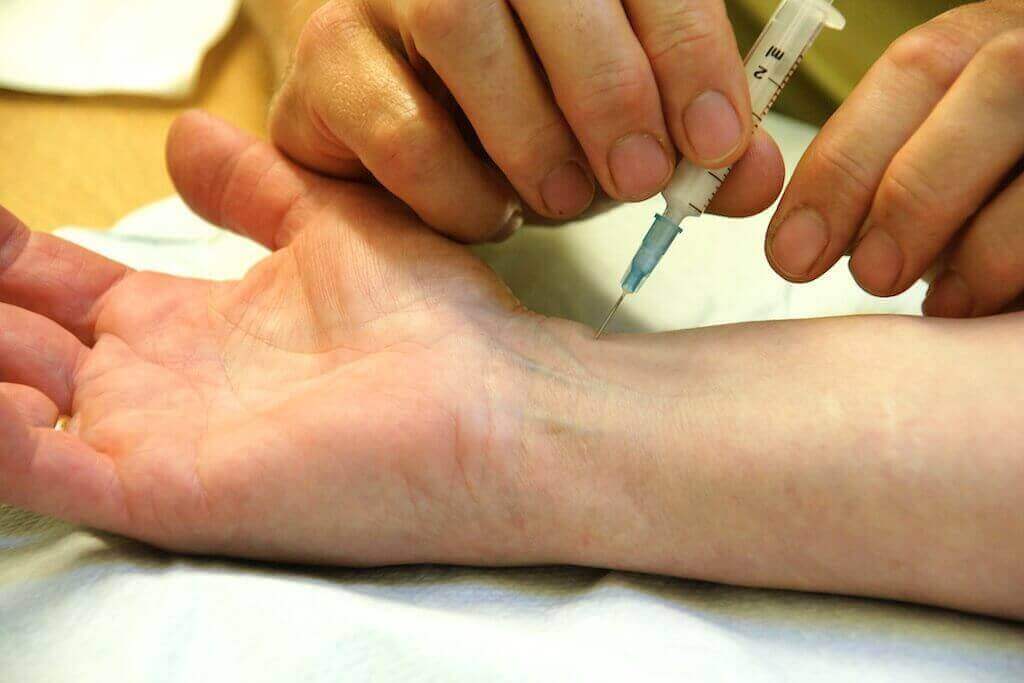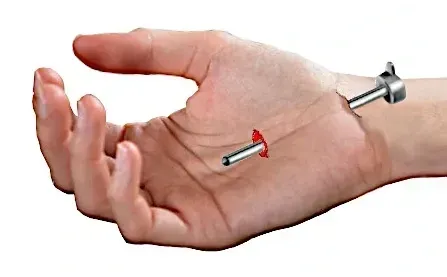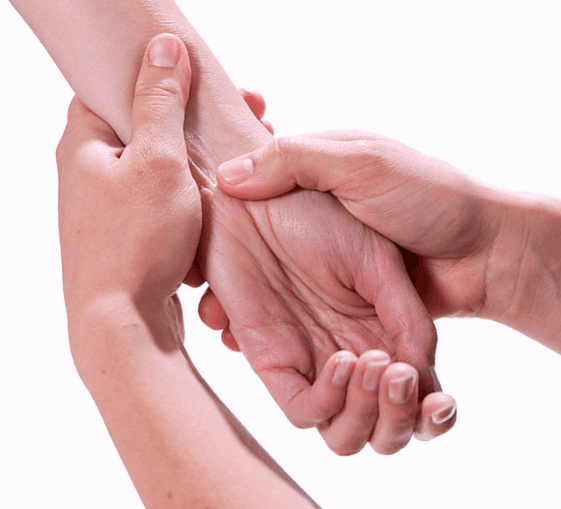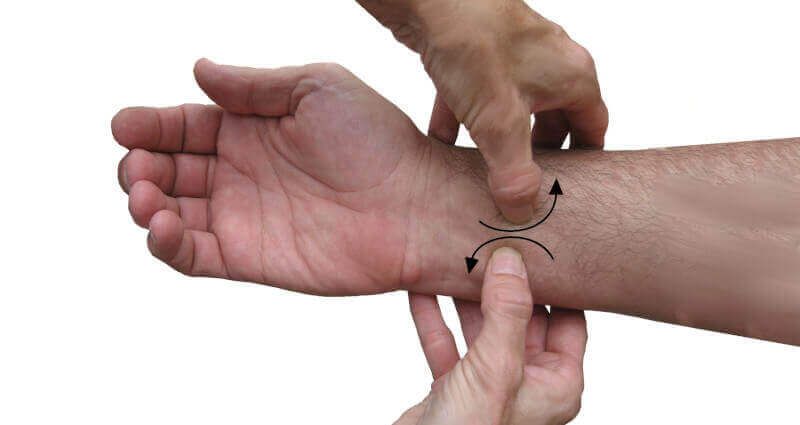What's Carpal Tunnel Syndrome?
And How To Treat It Without Surgery
Table of Contents
Overview
Introduction
Main symptoms of carpal tunnel
How do you get carpal tunnel?
How is carpal tunnel treated?
- NSAID drugs
- Steroid shots
- Carpal tunnel release surgery
- Myofascial release massage
- How myofascial release massage works
- How a therapists performs myofascial release massage
- How YOU can perform myofascial release massage
- CarpalRx performs myofascial release massage AUTOMATICALLY
Summary
FAQs
About
Overview
When asking, "What's carpal tunnel?" we have to understand its symptoms AND what causes them. The
National Institutes of Health says over 6 million Americans have carpal tunnel syndrome, and that number is growing every year. The root cause of carpal tunnel is swelling inside your wrist joint which exerts pressure on your median nerve. As the nerve is crushed, it becomes irritated. This results in all of the signs and symptoms of carpal tunnel, like hand pain, numbness, tingling, and weakness. Carpal tunnel syndrome can be treated non-surgically with medicines and myofascial release massage. It can also be treated surgically using one of two basic operative methods.
Introduction
Carpal tunnel syndrome is a
progressive neurological disorder affecting the hand and fingers. It usually occurs in people who use their hands a lot, or use excessive or repetitive force. The most common
hand and finger activities associated with getting carpal tunnel are:
- Forceful or prolonged gripping (holding a screw driver or
hairbrush)
- Excessive or prolonged pinching (sewing,
holding dental tools, a pencil or a
fine paint brush)
- Repetitive grip-and-release motions (grocery sorting, shoveling)
- Repetitive finger motions (using a
keyboard,
guitar, game console, piano)
- Using
vibrating tools (power saw, drill, or sander)
- Forceful wrist extension (pushing or lifting heavy objects or push-ups)
Carpal tunnel syndrome is common in professions which necessitate these hand and finger activities. That's why it is prevalent in artists, hair stylists, dental hygienists, carpenters, clerks,
gamers, machinists, weight lifters, and almost all computer users.
Main symptoms of carpal tunnel
How do you get carpal tunnel?
How is carpal tunnel treated?
It probably seems obvious, but the solution to de-compressing the median nerve due to adjacent swollen tendons is to relieve the compression. So how can this be done?
1. NSAID drugs
2. Steroid shots
3. Carpal tunnel release surgery
4. Myofascial release massage
How myofascial release massage works
How a therapists performs myofascial release massage
How YOU can perform myofascial release massage
Anyone can learn this technique to eliminate ALL symptoms of carpal tunnel syndrome. However, it’s cannot be performed very well on yourself. That's because
two
thumbs are best to use. So it’s better to find a willing partner to help.
Step 1
Find a quiet room where you and your partner can relax. It's preferable if you recline or lie down.
Step 2
Apply massaging oil to the palm-side of your wrist and forearm.
Step 3
Your partner sits in front of you so that your fingers point at them. Then they identify the area to be massaged. This area is approximately the first two inches below the wrist (see image above), and from left to right.
Step 4
Both of your partners' hands should cradle the back side of your hand. With their thumbs on top of your wrist and forearm, their thumbs make semi-circular motions on your skin. These semi-circular motions are in counter-rotating directions. That means when the thumbs are close to each other, they cause a shearing motion on the skin. The result looks similar to kneading bread dough.
Step 5
Your partners' thumbs should dig fairly deep into your forearm skin, without causing your discomfort. In doing so, they will feel your ropy flexor tendons below.
Step 6
Perform the massage for 15 minutes. And performed it twice a day; once in the morning and once before going to sleep.
Step 7
Use this regimen for at least 30 days. If you symptoms are more
severe, you may need 60 days of this therapy.
Additional tips for your massage
These additional tips help boost the effects of the myofascial release massage during the therapy period.
- After the nightly massage session (not morning) warm your wrist, hand, and fingers with a heating pad. Adjust the setting to
medium
or
low.
It’s best to roll up the heating pad into a tube, which you can hold with tape. While your hand is in a warm tube, the palm and knuckle surfaces are BOTH sufficiently heated.
- Wear a night brace while sleeping. Be sure to use a
certified carpal tunnel night brace.
There are only about 6 available on the market,
and they cannot be found in chain pharmacies.
Specifically, a
certified carpal tunnel brace does not have a metal palmar spine. Instead, the spine is located on the knuckle-side or the lateral sides of the hand. A palmar spine will only make your symptoms feel worse when you wake up in the morning.
- Never wear a wrist or hand brace during the daytime. The wrist of a person with carpal tunnel syndrome already has strained and damaged tissues. Adding a restrictive brace to it while it’s trying to do its daily job only adds additional strain.
- Perform regular hand and finger stretching exercises every 2-3 hours during the daytime. There are
4 core stretches which must be performed by every carpal tunnel sufferer. These are the
prayer stretch, finger interlace stretch, stop stretch, and thumb stretch.
5) CarpalRx performs myofascial release massage AUTOMATICALLY
Summary
What's carpal tunnel syndrome all about? The key is understanding how wrist tendons become sticky and then inflamed. That inflammation (and swelling) crushes the adjacent median nerve. When the median nerve is crushed it produces all of the symptoms of carpal tunnel syndrome. These include pain, tingling, numbness, burning, shooting electric shocks, weakness, and clumsiness. So how is carpal tunnel treated? Drugs, steroid shots, and even surgery are not a permanent fix to the problem. That's because none of these remedies address the underlying source of problem: tendon adhesions and inflammation. Only myofascial release massage can address this. It breaks up adhesions and allows the inflammation around tendons to subside - permanently. Essentially, it restores the normal balance inside the wrist joint. That means carpal tunnel symptoms are gone for good.
FAQs
Anyone can get carpal tunnel syndrome. However, certain factors put you at higher risk for getting it. Chief among them are performing harmful activities with your hands and fingers.
- What's the best treatment without surgery?
Medicines, steroid injections, and myofascial release massage are highly effective, especially when symptoms are mild or moderate.
- Is surgery always successful?
No, surgery has a 50-60% success rate. That means by year two, about half of patients are not satisfied with their surgical results. The main reason for dissatisfaction is return of symptoms.
About


